ISSN ONLINE(2319-8753)PRINT(2347-6710)
ISSN ONLINE(2319-8753)PRINT(2347-6710)
Saranya C, Vinoth P
|
| Related article at Pubmed, Scholar Google |
Visit for more related articles at International Journal of Innovative Research in Science, Engineering and Technology
In recent years, Cloud Computing has achieved greater heights. Cloud storage is more preferable than normal local storage, as when we use global internet based storage, it is easy to use wherever we go. But these cloud infrastructures are prone to threats like Cloud Service Provider may behave unfaithful towards the users data and also users may faulty perform improper operations that leads to loss of data. The solution for the above problem is that a Flexible Auditing Mechanism was proposed which allows a Third Party Auditor (TPA) to verify the integrity of data stored in the cloud .It uses the fragment structure and secure tag generation method for periodic sampling audit process .It also supports audit for dynamic operations. This audit service can provide public auditability without downloading raw data and protect privacy of the data. Therefore, through this audit system the dynamic data operations and timely anomaly detection can be supported at low storage and communication cost.
Keywords |
| Storage Auditing, data integrity, cloud storage systems. |
INTRODUCTION |
| Cloud computing is an upcoming technology where the computing resources are shared across internet for usage, that is we can pay as we use. There is no need for any local storage .The storage in clouds has become a popular way of storing and maintaining the data. The integrity of stored data should be preserved. But cloud infrastructures are prone to threats. These threats can be internal threat, caused by virtual machine failure or external threat, caused by system holes. This damages the integrity of data. |
| The next issue is that the cloud service provider would behave unfaithful towards the cloud data. They may discard the data that are rarely accessed or not accessed to save storage space and claim that the owner’s data are correctly stored in the cloud. The other issue is that users may perform improper operations that is they may accidently delete the data and claim the cloud service provider is responsible for the data loss. So, it is necessary for the service provider to have a flexible auditing service to check the correctness of the data stored in the cloud. Audit involves the tracking of all activities that includes data accesses, security violations, and attacks and so on. However, traditional cryptographic schemes lack to support integrity verification without the local copy of the data. If the audit services are designed to download the whole data which incurs storage and communication cost. This situation should be managed so, the main objectives of the flexible auditing services are: |
| Efficient Auditability. |
| To have a third party auditor (TPA) to verify the correctness of the data without downloading the whole data. |
| Dynamic Auditability. |
| To support auditing for dynamic operations done by the user. |
| Periodic detection of errors and losses. |
| To perform a periodic sampling audit on the data stored in the cloud. |
| Forensic Evidences. |
| To provide forensic evidences for the anomalies those occur in the cloud. |
| Lightweight Audit Tasks. |
| To incur the less cost computation audit tasks. |
| To achieve these objectives, a flexible auditing service was introduced to provide efficient integrity verification. This audit system supports dynamic data operations and timely anomaly detection. The techniques used are fragment structure, random sampling and index-hash table. The rest of the paper is organized as follows: Section 2 describes the research background and related work. Section 3 describes the audit system architecture and the techniques used. Section 4 describes the definition and the algorithms. Section 5, we present the performance of the experimental results. Finally, we conclude the paper in Section 6. |
BACKGROUND AND RELATED WORK |
| Traditional schemes based on the hash functions and signature methods can’t work without downloading the whole data. That results in expensive communication especially for large-size files. As the work of auditing the cloud data are really expensive and complex. This auditing work of verifying the correctness of the data is moved from cloud service provider (CSP) to the third party auditor (TPA).TPA has the capability for periodically auditing the data.This service gives data assurance and acts as a digital forensics. Many researchers proposed new notations for public auditability like the notions of proof of retrievability (POR)[2] and PDP[5]. Anyone can use these schemes to prove the correctness of the data and offer a publicly accessible remote interface to check large amount of data. Some audit services solutions are there. Xie et al. [10] proposed a content comparability method but it is not suitable for irregular data. Wang et al. [11] proposed a privacy preserving property for outsourced data. In this scheme, a file is directly split into n blocks and a verification tag is generated for each block. Here, the size of the block is equal to the cryptosystem.For,160 bits which is 20 bytes. That is,1M bytes file is split into 50,000 blocks and generates 50,000 tags , this storage of tags is 1M bytes. So, it is inefficient to construct a system using this scheme. |
| To overcome this problem, a fragment structure technique is used to reduce the extra storage. Using this scheme, the data can be dynamically updated by the clients. The block operations like modification, deletion and insertion. |
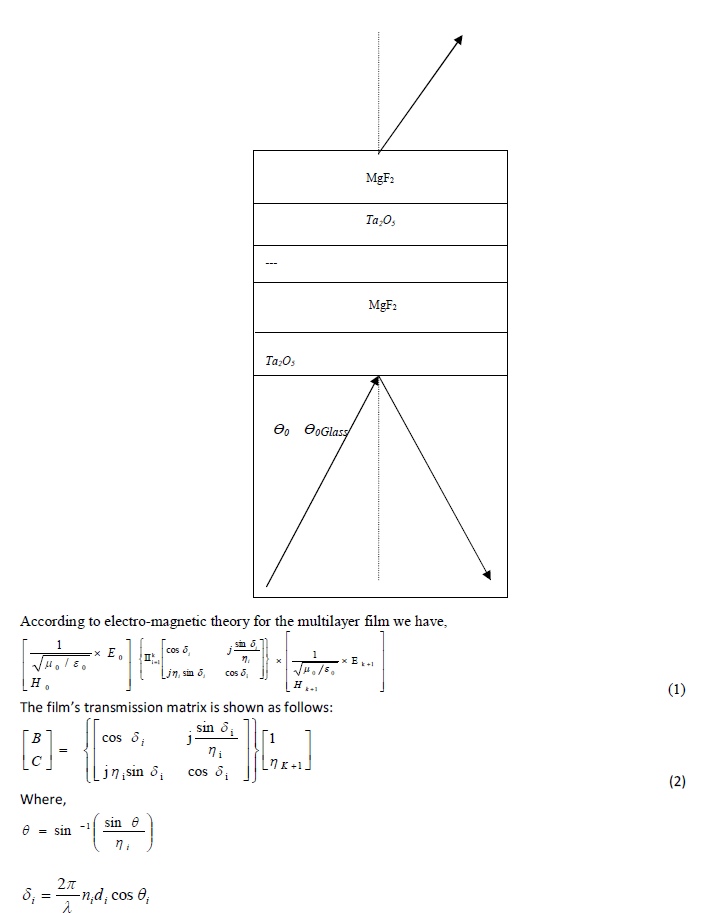 |
| In the existing schemes, security issues arise a lot. Hence, to develop a secure mechanism for dynamic audit services, a flexible scheme is required. |
ARCHITECTURE AND TECHNIQUES |
| Audit system architecture for outsourced data in clouds is shown in Fig. 1.This architecture the audit architecture consists of five entities. |
| Cloud Service Provider(CSP) |
| CSP provides data storage service and has enough storage space and computation resources. |
| Authenticated Applications(AA) |
| AA has the right to access and manipulate the stored data |
| Data Owner (DO) |
| DO have a large amount of data to be stored in the cloud. |
| Third Party Auditor(TPA) |
| TPA has capabilities to manage or monitor the outsourced data under the delegation of DO. |
| Application User’s |
| Cloud User’s enjoy various cloud application services via the AA’s. |
| TPA is reliable and independent through the following audit functions: |
| TPA should be able to make regular checks on the integrity and availability of the delegated data at appropriate intervals. |
| TPA should be able to organize, manage, and maintain the outsourced data instead of DO |
| TPA support dynamic data operations for AAs. |
| TPA should be able to take the evidences for disputes about the inconsistency of data in terms of authentic records for all data operations. |
| To achieve these functions, our audit services has 3 processes: |
| Tag Generation And User’s Verification: The client (DO) uses a secret key sk to preprocess a file, which consists of a collection of n blocks, generates a set of public verification parameters (PVP’s) and IHT that are stored in TPA, transmits the file and some verification tags to CSP, and may delete its local copy(see Fig.2a); |
| Periodic Sampling Audit: By using an interactive proof protocol of retrievability, TPA issues a “random sampling” challenge to audit the integrity and availability of the outsourced data in terms of verification information (involving PVP and IHT) stored in TPA(see Fig. 2b);and |
| Audit For Dynamic Data Operations: An AA, who holds a DO’s secret key λ, can manipulate the outsourced data and update the associated IHT stored in TPA. The privacy of λ and the checking algorithm ensure that the storage server cannot cheat the AAs and forge the valid audit records(see Fig. 2c); |
| The Authorized Application’s provides the cloud application services, must be authorized by the DOs. Therefore, any AAs must give TPA the authorized information to perform the dynamic operations on the data. If any unauthorized applications occur then the auditing service should detect it. So, this is a strong authentication-verification mechanism. |
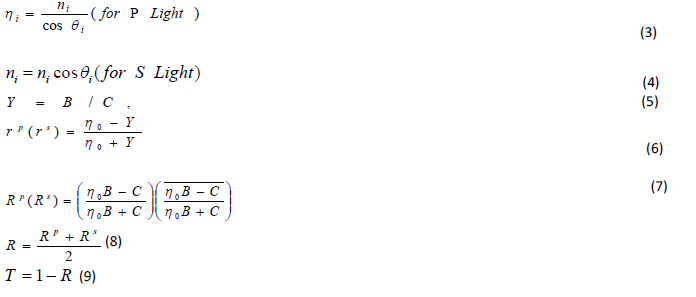 |
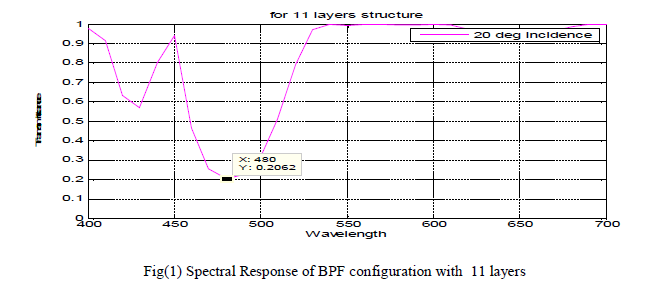 |
| Fig. 2. Three processes of the audit system. |
| The entire goal of this audit structure is to provide the creditability in cloud. So, the burden of the DO and CSP are greatly reduced. The entire auditing service is handled by a Trusted Third Party Auditor (TTPA).There is no additional cost for using this mechanism. |
| This process involves the following algorithms: KeyGen, TagGen, Update, and Delete, Insert algorithms. |
| The following techniques are required to construct a this algorithms. The techniques are Fragment structure, Bilinear Mapping and Index table (ITable). |
| 3.1 Fragment Structure and Secure Tags |
| To maximize the performance the audit system, a general fragment structure is used.A file F is split into n data components {m1,….,mn}.Each data block mi is further split into si sectors. |
| 1. Select the maximum no. of sectors smax among all the sector numbers si . |
| 2. mi has smax sectors Set mij=0 for si < j <_ smax |
| 3. Size of each sector is constant and equal to security parameter p. |
| 4. Calculate the number of data blocks. |
| 5. Encrypted data component is |
| M ïÃâ¬Ã½{mij}iïÃÆÃŽ[1,n], jïÃÆÃŽ[1, s] |
| where |
| s = number of sectors in each data block. |
| p= security parameter. |
| 3.2 Bilinear Mapping |
| Let G1,G2 and GT be multiplicative groups with same prime order p. Bilinear map is given by |
| e:G1*G2→GT |
| Let g1 and g2 be the generators of G1 and G2 . . Keyed secure hash function |
| h :{0,1}*→G1 |
| 1.3 Index table (ITable) |
| ITable is used to record the abstract information of the data .It consists of 4 components Index -Current block number of data block mi.. Bi -Original block number of data block mi . Vi -Current version number of data block mi . Ti-Timestamp used for generating the data tag . |
 |
ALGORITHMS FOR AUDIT SYSTEM |
| The algorithms for tag generation process: |
| 1. Key Generation Algorithm - KeyGen(λ) |
| Algorithm KeyGen (λ) |
| //Input: λ security parameter |
| //Output: skh secret hash key |
| // skt secret public tag key |
| // pkt public tag key |
| begin |
| Choose 2 random numbers skt , skh ÃÂÃâ Zp |
| Compute |
| end |
| 2. Tag Generation Algorithm -TagGen(M, skt, skh) |
| Algorithm TagGen (M, skt, skh ) |
| //Input: M encrypted file |
| // skh secret hash key |
| // skt secret public tag key |
| //Output: T set of tags |
| begin |
| Choose s random values x1 , x2,… xs. ÃÂÃâ Zp |
| Compute |
| for each data block mi |
| Compute |
 |
| end for |
| end |
| where |
| Wi = FID || i . |
| FID = identifier of data. |
| i = block number of mi. |
| 3. Challenge Algorithm - Chall (Minfo ) |
| Algorithm Chall (Minfo ) |
| // Input: Minfo Abstract information of data |
| // Output: C Challenge |
| begin |
| Select some data blocks and construct challenge set Q |
| for each chosen block mi |
| Generate random numbers vi ÃÂÃâ Zp |
| Compute challenge stamp |
| R ( pkt) |
| end for |
| return C=({i,vi}iÃÂÃâQ,R) |
| end |
| where r = randomly chosen number |
 |
| 4. Proof Algorithm - Prove (M,T,C ) |
| Algorithm Prove (M,T,C ) |
| //Input: M File |
| // T Tag from auditor |
| // C Challenge |
| //Output: P= (TP,DP) Proof |
| // TP Tag Proof |
| // DP Data Proof |
| begin |
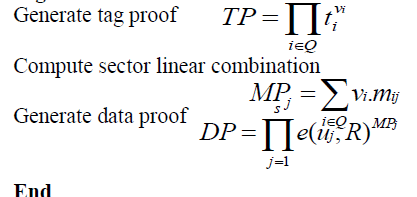 |
| 5. Verification Algorithm - Verify (C ,P, skh, pkt ,Minfo) |
| ïÃâ÷ The output of this algorithm is 0 means then , the integrity of the cloud data is compromised. |
| Algorithm Verify (C ,P, skh, pkt , Minfo) |
| // Input: T tag from auditor |
| // C challenge |
| // skh secret hash key |
| // pkt public tag key |
| // Minfo abstract information of data |
| // Output: 0 or 1 |
| begin |
| Compute identifier hash values h=(skh,Wi). Compute challenge hash |
 |
| if both the values are equal then |
| return 1 |
| else |
| return 0 |
| end if |
| end |
CONSTRUCTION OF THE AUDIT SCHEME |
| This scheme includes a 2-move interactive proof protocol, which also provides privacy protection property to ensure the confidentiality of secret data. |
| 5.1 Notations |
 |
| hash function of BLS signatures.Bilinear pairings proposed by Boneh and Franklin [11] is used . Let G and GT be two multiplicative groups using elliptic curve conventions with a large prime order p. The function e be a computable bilinear map e : G x G-> GT .with the following properties: 1) Bilinearity2) Nondegeneracy and 3) Computability. The file is encrypted using collision resistance algorithm by using the bilinear mapping and then the tags are generated for this file which is fragmented. |
| 5.2 Construction for Dynamic Auditing |
| Data update. There are three types of data update operations that can be used by the owner: modification, insertion, and deletion. For each update operation, there is a corresponding algorithm in the dynamic auditing to process the operation and facilitate the future auditing, defined as follows: Data update. There are three types of data update Operations that can be used by the owner: modification, insertion, and deletion. For each update operation, there is a corresponding algorithm in the dynamic auditing to process the operation and facilitate the future auditing, defined as follows: |
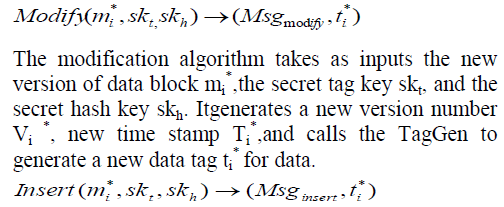 |
| The insertion algorithm takes as inputs the new data block mi , the secret tag key skt, and the secret hash key skh. It inserts a new data block mi before the ith position. It generates an original number Bi, a new version number Vi , and a new time stamp Ti . Then, it calls the TagGen to generate a new data tag ti for the new data block mi. It outputs the new tag ti and the update message |
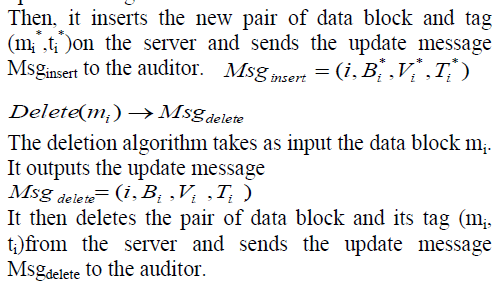 |
CONCLUSION |
| In this paper, a flexible auditing mechanism was proposed by using Bilinearity property of bilinear pairing and also supports audit for dynamic operations. This enhances the performance of TPAs. |